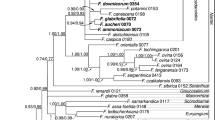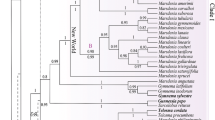Abstract
Gleichenia boryi is a poorly known species of Gleicheniaceae endemic to Madagascar and La Réunion Island. Although Kunze pointed out in his description that this fern was distinct from other Gleicheniaceae in its leaf morphology, the generic relationships of this fern have not been investigated until now. Taking advantage of DNA sequences obtained from a sample of this species obtained in La Réunion Island and a sample of the type species Gl. polypodioides, we tested the hypothesis that the morphological distinction reflects the phylogenetic isolation of Gl. boryi. By reconstructing the phylogenetic relationships and divergence time estimates, we were able to show that this fern is not closely related to Gleichenia s.s. and represents a distinct lineage segregated from other Gleicheniaceae since the Cretaceous. Thus, a new generic name Rouxopteris (gen. nov.) and a new combination R. boryi (comb. nov.) are introduced to improve the generic classification of this family. We also discussed the evolutionary history of the Gleicheniaceae in the context of the Cretaceous terrestrial revolution.




Similar content being viewed by others
References
Badré F (2008) Gleicheniaceae. In: Bosser J, Badré F, Guého J (eds) Flore des Mascareignes, La Réunion, Maurice, Rodrigues. Ptéridophytes, familles 1 a 26. IIRD, MSIRI, RBG-Kew, pp 65–70
Baker JG (1901) Diagnoses Africanae XIII. Kew Bull 119–138
Bernhardi JJ (1805) Dritter Versuch einer Anordnung der Farrnkraeuter. Schrader’s Neues J Bot 1:1–50
Bierhorst DW (1968) On the Stromatopteridaceae (fam. Nov.) and on the Psilotaceae. Phytomorphology 18:232–268
Bryant D, Moultan V (2004) Neighbor-Net: an agglomerative method for the construction of phylogenetic networks. Molec Biol Evol 21:255–265. https://doi.org/10.1093/molbev/msh018
Ching RC (1940) On the genus Gleichenia Smith. Sunyatsenia 5:269–289
Ching RC (1978) The Chinese fern families and genera: systematic arrangement and historical origin. Acta Phytotax Sin 16:16–37
Ching RC, Wang CH, Shing GH (1959) Glecheniaceae. In: Ching RC (ed) Flora Reipublicae Popularis Sinicae, vol. 2. Science Press, Beijing, pp 116–132
Chinnock RJ, Bell GH (1998) Gleicheniaceae. In: Flora of Australia 48, Ferns, Gymnopserms and allied Groups. ABRS/CRISRO, Melbourne, pp 148–161
Christenhusz MJM, Zhang XC, Schneider H (2011) A linear sequence of extant families and genera of lycophytes and ferns. Phytotaxa 19:7–54
Christensen C (1906) Index Filicum LV. Apud H, Hagerup, Hafniae
Christensen C (1932a) The Pteridophyta of Madagascar. Dansk Bot Ark 7:1–253
Christensen C (1932b) Filices. In: Perrier de la Bathie H (ed) Catalogue des Plantes des plantes de Madagascar. Imprimerie G. Pitot & Cie, Tananarive, pp 1–72
Chrysler MA (1944) The vascular structure of the leaf of Gleichenia. II. Petiolar bundle. Amer J Bot 31:483–491
Copeland EB (1909) New genera and species of Bornean ferns. Philipp J Sci C, Bot 3:343–351
Copeland EB (1947) Genera Filicum, the genera of ferns. Chronica Botanica, Waltham
Darriba D, Taboada GL, Doallo R, Posada D (2012) jModeltest 2: more models, new heuristics and parallel computing. Nat Meth 9:772
Doyle JJ, Doyle JL (1987) A rapid DNA isolation procedure for small quantities of fresh leaf tissue. Phytochem Bull Bot Soc Amer 19:11–15
Drummond AJ, Suchard MA, Xie D, Rambaut A (2012) Bayesian phylogenetics with BEAUTi and BEAST 1.7. Molec Biol Evol 29:1969–1973. https://doi.org/10.1093/molbev/mss075
Gandolfo M, Nixon K, Crepet W, Ratcliffe G (1997) A new fossil fern assignable to Gleicheniaceae from Late Cretaceous sediments of New Jersey. Amer J Bot 84:483–493. https://doi.org/10.2307/2446025
Gonzales JR, Kessler M (2011) A synopsis of the Neotropical species of Sticherus (Gleicheniaceae), with descriptions of nine new species. Phytotaxa 31:1–54
Grangaud E (2010) Guide des Fougères et plantes alliées des Mascareignes - La Réunion, Maurice et Rodrigues. Biotope, Mèze (collection Parthénope); Muséum national d’ Historie naturelle, Paris
Hennequin S, Kessler M, Lindsay S, Schneider H (2014) Evolutionary patterns in the assembly of fern diversity on the Mascarene Islands. J Biogeogr 41:1651–1663. https://doi.org/10.1111/jbi.12339
Herendeen PS, Skog JE (1998) Gleichenia chaloneri - a new fossil fern from the lower Cretaceous (Albian) of England. Int J Pl Sci 159: 870–879. https://www.journals.uchicago.edu/doi/10.1086/297609
Holttum RE (1957a) Morphology, growth-habit, and classification in the family Gleicheniaceae. Phytomorphology 8:168–184
Holttum RE (1957b) On the taxonomic subdivision of the Gleicheniaceae with descriptions of the new Malaysian species and varieties. Reinwardtia 4:257–280
Holttum RE (1959) Gleicheniaceae. Flora Malesiana Series 2. Pteridophyte 1:1–36
Huson DH, Bryant D (2006) Application of phylogenetic networks in evolutionary studies. Molec Biol Evol 23:254–267. https://doi.org/10.1093/molbev/msj030
Jin XF, Ding BY, Iwatsuki K (2013) Gleicheniaceae. In: Wu ZY, Raven PH, Hong DY (eds) Flora of China, vols. 2–3. Science Press, Beijing; Missouri Botanical Garden Press, St. Louis, pp 110–115
John SH (1942) New combinations in the Gleicheniaceae and in Stephelia (Epacridaceae). Occas Pap Bernice Pauahi Bishop Mus 17:79–84
Kramer KU (1990) Gleicheniaceae. In: Kubitzki K (ed) The Families and Genera of Vascular Plants, vol. 1. Pteridophytes and Gymnosperms. Springer, Berlin, pp 145–152
Kunze G (1844) Farnkraeuter in kolorirten Abbildungen naturgetreu erlaeutert und beschrieben. Schtuhr’s Farnkraeuter Supplement Band 1, Heft 7. Ernst Fleischer, Leipzig
Li CX, Lu SG, Ma JY, Yang Q (2010) Phylogeny and divergence of Gleicheniaceae inferred from three plastid genes. Acta Palaeontol Sin 49:64–72
Lockhart PJ, Steel MA, Hendy MD, Penny D (1994) Recovering evolutionary trees under a more realistic model of sequence evolution. Molec Biol Evol 11:605–612
Maddison WP, Maddison DR (2018) Mesquite: a modular system for evolutionary analysis. Version 3.50. Available at: http://mesquiteproject.org
Mettenius GH (1861) Filices Novae Caledoniae. Ann Sci Nat, Bot 4:55–91
Mildbread J (1934) Neue und seltene Arten aus Ostafrika (Tanangyika-Territ. Mandat) leg. H.J. Schlieben VI. Notizbl Königl Bot Gart Mus Berlin 12:79–109
Nagalingum NS, Cantrill DJ (2006) Early Cretaceous Gleicheniaceae and Matoniaceeae (Gleicheniales) from Alexander Island, Antarctica. Rev Palaeobot Palynol 138:73–93. https://doi.org/10.1016/j.revpalbo.2005.11.001
Nakai T (1950) A new classification of Gleicheniales. Bull Nat Sci Mus 29:1–71
Nakaike T (1975) Enumeratio Pteridophytarum Japonicarum. University Tokyo Press, Tokyo, Filicales
Perrie LR, Bayly MJ, Lehnebach CA, Brownsey PJ (2007) Molecular phylogenetic and molecular dating of the New Zealand Gleicheniaceae. Brittonia 59:129–141
Perrie LR, Shepherd LD, Brownsey PJ (2012) Gleichenia inclusisora, a new and uncommon tangle fern from New Zealand. New Zealand J Bot 50:401–410. https://doi.org/10.1080/0028825X.2012.724015
PPG1 (2016) A community-derived classification for extant lycophytes and ferns. J Syst Evol 54:563–603. https://doi.org/10.1111/jse.12229
Presl CB (1825) Reliquiae Haenkeanae seu descritiones et ícones plantarum quas in America meridionali et boreali, in insulsi Philippinis et Marianis colleget Thaddaeus Haenke, Tomus 1. J.G. Calve, Prague
Presl CB (1836) Tentamen Pteridographiae seu genera filicacearum praisertim junta venarum decursum et distributional exposita. Typis Filiorum Theophili Haase, Prague
Presl CB (1847) Die Gefaessbuendel im Stipes der Farrn. K.K.Hofbuchdruckerei von Gottlieb Haase Söhne, Prague
Presl CB (1851) Epimeliae Botanicae. Abh Königl Böhm Ges Wiss 4:361–624
Pryer KM, Schuettpelz E, Wolf PG, Schneider H, Smith AR, Cranfill R (2004) Phylogeny and evolution of ferns (monilophytes) with a focus on the early leptosporangiate divergences. Amer J Bot 91:1582–1598. https://doi.org/10.3732/ajb.91.10.1582
Pybus OG, Harvey PH (2000) Testing macro-evolutionary models using incomplete molecular phylogenies. Proc Roy Soc London B 267:2267–2272. https://doi.org/10.1098/rspb.2000.1278
Reinward CGC (1825) Filices. In: Hornschuch CF (ed) Sylloge Plantarum Novrarum itemque minus cognitarum: a praestantissimis botanicus adhuc viventibus collecta et a Societate regia botanica Ratisbonensi 2. Typis viduae C.E.Brenk, Regensburg, pp 2–3
Rodway L (1903) Tasmanian Flora. J. Vail, Government Printer, Hobart
Ronquist F, Teslenk M, van der Mark P, Ayres DL, Darling A, Hoehna S, Larget B, Liu L, Suchard MA, Huelsenbeck JP (2012) MrBayes 3.2: efficient Bayesian phylogenetic inference and model choice across a large model space. Syst Biol 61:539–542. https://doi.org/10.1093/sysbio/sys029
Roux JP (2009) Synopsis of the Lycopodiophyta and Pteridophyta of Africa, Madagascar and neighbouring islands. Strelitzia 23:1–296
Schneider H, Schuettpelz E, Pryer KM, Cranfill R, Magallon S, Lupia R (2004) Ferns diversified in the shadow of angiosperms. Nature 428: 553–557. https://www.nature.com/articles/nature02361
Schuettpelz E, Pryer KM (2007) Fern phylogeny inferred from 400 leptosporangiate species and three plastid genes. Taxon 56:1037–1050. https://doi.org/10.2307/25065903
Schuettpelz E, Pryer KM (2009) Evidence for a Cenozoic radiation of ferns in an angiosperm-dominated canopy. Proc Nat Acad Sci USA 106:11200–11205. https://doi.org/10.1073/pnas.0811136106
Shaw SW, Ranker TA (2011) New and improved leaf terminology for Gleicheniaceae. Amer Fern J 101:117–124. https://doi.org/10.1640/0002-8444-101.2.117
Shu JP, Shang H, Jin DM, Wei HJ, Zhou XL, Liu HM, Gu YF, Wang Y, Wang FG, Shen H, Zhang R, Adjie B, Yan YH (2017) Re-establishment of species from synonymies based on DNA barcoding and phylogenetic analysis using Diplopterygium simulans (Gleicheniaceae) as an example. PLoS ONE 12:e0164604. https://doi.org/10.1371/journal.pone.0164604
Skog JJ (2001) Biogeography of Mesozoic leptosporangiate ferns related to extant ferns. Brittonia 53:236–269
Smith JE (1973) Tentamen botanique de filicum generis dorsiferaraum. Mém Acad Roy Sci Turin 5:401–423
Smith AR, Pryer KM, Schuettpelz E, Korall P, Schneider H, Wolf PG (2006) A classification for extant ferns. Taxon 55:705–731. https://doi.org/10.2307/25065646
Smith AR, Pryer KM, Schuettpelz E, Korall P, Schneider H, Wolf PG (2008) Fern classification. In: Haufler CH, Ranker TA (eds) Biology and Evolution of Ferns and Lycophytes. Cambridge University Press, Cambridge, pp 417–465
Stamatakis A (2006) RAxML-VI-HPC: maximum likelihood based phylogenetic analyses with thousands of taxa and mixed models. Bioinformatics 22:2688–2690. https://doi.org/10.1093/bioinformatics/btl446
Swofford DL (2003) PAUP: phylogenetic analysis using parsimony (and other methods). Version 4.0b10. Sinauer Associates, Sunderland
Tardieu-Blot M-L (1982) Espèce et combinaison nouvelles de fougères des Mascareignes. Bull Mus Natl Hist Nat B sér. 4:103–105
Testo W, Sundue M (2014) A 4000-species dataset provides new insight into the evolution of ferns. Molec Phylogen Evol 105:200–211. https://doi.org/10.1016/j.ympev.2016.09.003
Tryon AF, Lugardon B (1991) The Spore of the Pteridophyta. Springer-Verlag, New York
Tryon RM, Tryon AF (1982) Ferns and allied Plants. Springer-Verlag, New York
Underwood LM (1907) American Ferns VIII. A preliminary review of the North American Gleicheiniaceae. Bull Torrey Bot Club 34:243–262
Verdcourt B (2000) Gleicheniaceae. In: Beentje HJ (ed) Flora of East Africa, Gleicheniaceae. AA Balkema, Rotterdam, pp 1–9
Wallich N (1829) Plantae Asiaticae Rariores or descriptions and figures of a select number of unpublished East Indian Plants 1. Richard Taylor, Printer to the University of London, London
Acknowledgements
Fieldwork in La Réunion Island was supported by the Conservatoire Botanique National de Mascarin, Parc National de La Réunion and the Universite de la Réunion. The study was financially supported by a Marie Curie Fellowship (PIEF-GA-2008-200447), a Darwin Now Award from the British Council (2009) and Recruitment Program of Global Experts (WQ2017530454), all three awarded to SH, and by projects from Xishuangbanna Tropical Botanical Garden, Chinese Academy of Sciences (2017XTBG-T03, 2017XTBG-F05) and funding from the Scientific Research Program of Sino-Africa Joint Research Center (SAJC201607). We thank Edmond Grangaud and Jean-Maurice Tamon for their kind support during visits to La Réunion.
Author information
Authors and Affiliations
Corresponding author
Ethics declarations
Conflict of interest
The authors are not aware of any potential conflicts of interests.
Human and animal rights
A plant-based research project the research did not involve human participants or animal-based experiments. All collections and experiments were carried out with the required permissions and standards.
Additional information
Handling editor: Martin A. Lysak.
Publisher's Note
Springer Nature remains neutral with regard to jurisdictional claims in published maps and institutional affiliations.
Electronic supplementary material
Below is the link to the electronic supplementary material.
606_2020_1657_MOESM1_ESM.nex
Supplementary material 1 Molecular Dataset used to reconstruct the Phylogenetic Hypothesis: Dataset includes all rbcL seqeunces given as a nexus format (NEX 56 kb)
Information on Electronic Supplementary Material
Information on Electronic Supplementary Material
Online Resource 1. Aligned matrix of rbcL sequences used in the study.
Rights and permissions
About this article
Cite this article
Liu, H., Rakotondrainibe, F., Hennequin, S. et al. The significance of Rouxopteris (Gleicheniaceae, Polypodiopsida): a new genus endemic to the Madagascan region. Plant Syst Evol 306, 30 (2020). https://doi.org/10.1007/s00606-020-01657-9
Received:
Accepted:
Published:
DOI: https://doi.org/10.1007/s00606-020-01657-9




